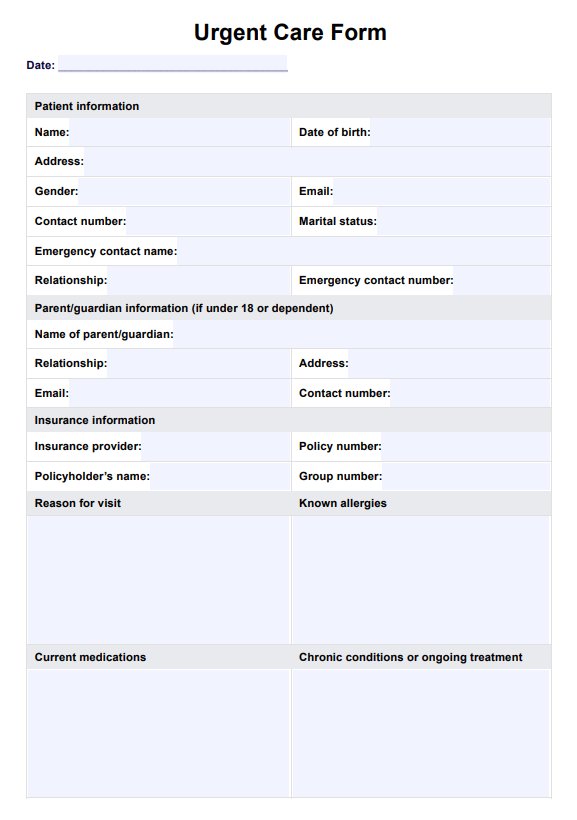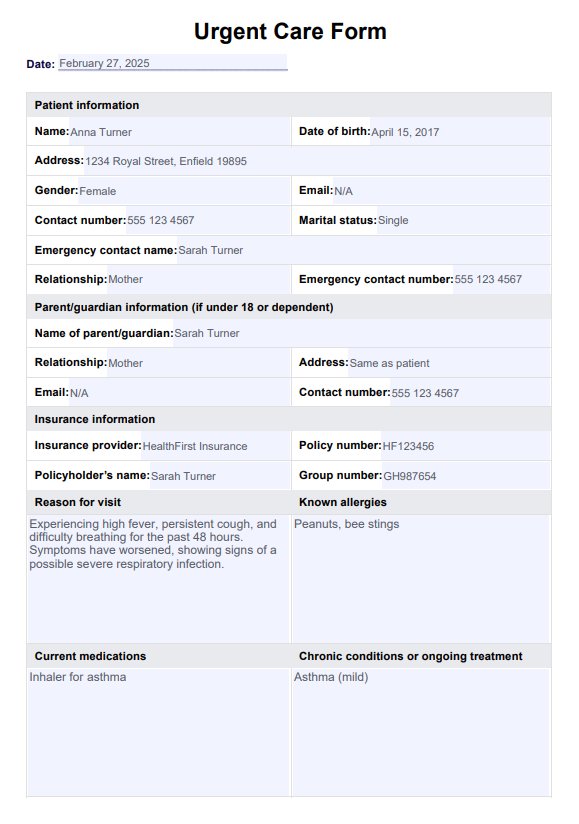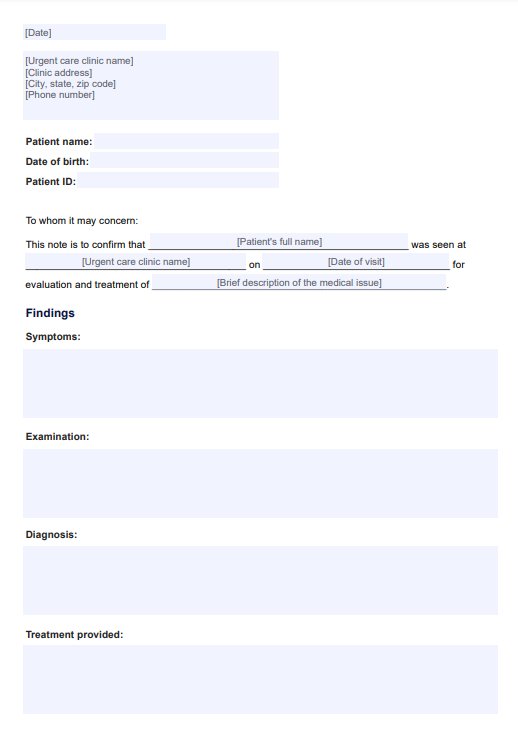Urgent Care Form
Streamline patient check-in and expedite care with our Urgent Care Form template, designed to efficiently gather vital patient information.


What is urgent care?
Urgent care is a walk-in clinic category focused on delivering ambulatory care in a dedicated medical facility outside of a traditional emergency room. It is designed to provide immediate medical attention for non-life-threatening illnesses or injuries requiring prompt care but not severe enough to warrant a visit to the emergency room. Urgent care centers are equipped to handle various medical issues, from minor cuts and burns to infections, sprains, and fractures.
Is urgent care and emergency care the same?
While urgent and emergency care address medical needs requiring prompt attention, they differ. Urgent care is intended for non-life-threatening conditions requiring immediate attention and services, while emergency care is for life-threatening or severe conditions requiring advanced medical treatment. It's essential to choose the right type of care based on the severity of the condition to ensure the best possible outcome.
Urgent Care Form Template
Urgent Care Form Example
What is an Urgent Care Form?
An Urgent Care Form is one of the essential patient forms used in urgent care centers to gather vital information from patients upon their arrival and add it to their medical records. It serves as a tool for efficient patient registration and helps expedite the care process for cases requiring urgent attention. These medical forms typically include sections for:
- Patient information: This section collects basic details such as name, date of birth, gender, contact information, and address.
- Emergency contact: Records the name, relationship, and contact information of someone who can be reached in an emergency.
- Reason for visit: Allows the patient to describe their symptoms or the reason for their urgent care visit.
- Medical history: Includes known allergies, current medications, chronic conditions, and any previous surgeries or hospitalizations.
- Responsible party/guardian information: This section gathers parent or guardian details for patients under 18 or dependents.
- Patient insurance information: Captures insurance provider, policy number, policyholder's name, and group number for billing purposes.
- Consent for treatment: This section includes statements where the patient or guardian consents to receive medical treatment and authorizes the release of medical information for insurance claims.
The consent parts of the form are particularly important as they ensure that the patient or their guardian agrees to the proposed medical treatment, gives informed consent, and understands the financial responsibilities involved. This section also helps protect the healthcare provider legally by documenting the patient's informed consent.
How does our Urgent Care Form template work?
Our Urgent Care Form template, similar to our new patient forms template, is designed to streamline the check-in process for patients requiring urgent medical attention. It ensures that you can gather all necessary information efficiently and effectively.
Step 1: Access the template
Access the latest version of the Urgent Care PDF template directly by clicking the "Use template" button. Alternatively, you can obtain a copy of the document from the Carepatron app or the template library. If you use the Carepatron app, you can share it online via a link with patients and fellow healthcare professionals without ever having to fax it.
Step 2: Explain the form
Upon a patient's arrival, bring them the form and walk them through it, explaining each section to ensure they understand what information is needed and why it's important.
Step 3: Fill out the form
Have the patient or their legal guardian complete the form with all the required details, including personal information, medical history, insurance information, and consent for treatment.
Step 4: Review and confirm
Once the form is completed, review the information with the patient to confirm accuracy. Address any questions or concerns they may have.
Step 5: Store securely
Keep the completed form securely in the patient's file for future reference. This ensures you have all the necessary information for the patient's care and billing.
When are Urgent Care Forms issued?
Urgent Care Forms are typically issued in several situations to ensure efficient and effective patient care:
- New patient check-in: When a new patient arrives at an urgent care center, the form is issued to gather their personal, medical, and insurance information.
- Follow-up visits: If a returning patient comes in for a follow-up visit, the form may be issued to update any changes in their information or medical condition.
- Minor emergencies: In minor emergencies like cuts, sprains, or mild infections, the form records the patient's details and the nature of their visit.
- Walk-in patients: For patients who walk in without an appointment, the form helps quickly register their information and assess their urgent care needs, significantly reducing wait time.
By issuing urgent care patient care forms in these situations, you can streamline the patient registration process and ensure they have all the necessary information to provide prompt and appropriate care.
Benefits of using our Urgent Care Form template
By adopting our urgent care intake form template, you can enhance their workflow, improve patient care, and ensure legal compliance while maintaining high professionalism. Here are some key benefits of using our template:
- Efficiency: The template streamlines the check-in process, allowing you to quickly gather all necessary patient information, which is crucial in urgent care settings where time is of the essence.
- Accuracy: The template provides a standardized format, ensuring that all important details are captured accurately, reducing the risk of errors or omissions.
- Legal compliance: The template includes sections for consent, which are essential for legal compliance and protecting both the patient and the healthcare provider.
- Customizability: The template can be easily customized to fit the specific needs of your urgent care center, ensuring that you collect all relevant information for your patient population.
Commonly asked questions
In healthcare, "urgent" refers to a condition or situation that requires prompt medical attention but is not life-threatening, typically needing care within 24 hours.
Emergency care is medical treatment provided for severe, life-threatening conditions that require immediate attention, such as heart attacks, strokes, or major injuries.
Urgent care addresses non-life-threatening conditions that need prompt attention, while emergency care is for serious, life-threatening issues requiring immediate, advanced medical intervention.












































































































